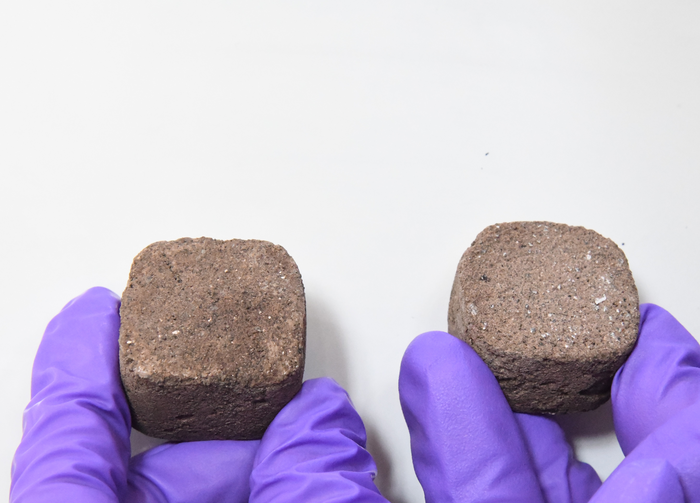In collaboration with the Indian Space Research Organisation (ISRO), a team of researchers from the Indian Institute of Science (IISc) has developed a sustainable method for making bricks out of Martian soil, using bacteria and urea. These “space bricks” can be used to construct building-like structures on Mars that could facilitate human settlement on the red planet.

Credit: Nitin Gupta
In collaboration with the Indian Space Research Organisation (ISRO), a team of researchers from the Indian Institute of Science (IISc) has developed a sustainable method for making bricks out of Martian soil, using bacteria and urea. These “space bricks” can be used to construct building-like structures on Mars that could facilitate human settlement on the red planet.
The method for making these space bricks has been outlined in a study published in PLOS One. A slurry is first created by mixing Martian soil with guar gum, a bacterium called Sporosarcina pasteurii, urea and nickel chloride (NiCl2). This slurry can be poured into moulds of any desired shape, and over a few days the bacteria convert the urea into crystals of calcium carbonate. These crystals, along with biopolymers secreted by the microbes, act as cement holding the soil particles together.
An advantage of this method is the reduced porosity of the bricks, which has been a problem with other methods used to consolidate Martian soil into bricks. “The bacteria seep deep into the pore spaces, using their own proteins to bind the particles together, decreasing porosity and leading to stronger bricks,” says Aloke Kumar, Associate Professor in the Department of Mechanical Engineering at IISc, one of the senior authors of the paper.
The research group had previously worked on making bricks out of lunar soil, using a similar method. However, the previous method could only produce cylindrical bricks, while the current slurry-casting method can also produce bricks of complex shapes. The slurry-casting method was developed with the help of Koushik Viswanathan, Assistant Professor in the Department of Mechanical Engineering, IISc, whose lab works on advanced manufacturing processes. In addition, extending the method to Martian soil proved challenging. “Martian soil contains a lot of iron, which causes toxicity to organisms. In the beginning, our bacteria did not grow at all. Adding nickel chloride was the key step in making the soil hospitable to the bacteria,” explains Kumar.
The group plans to investigate the effect of Mars’ atmosphere and low gravity on the strength of the space bricks. The Martian atmosphere is 100 times thinner than Earth’s atmosphere, and contains over 95% carbon dioxide, which may significantly affect bacterial growth. The researchers have constructed a device called MARS (Martian AtmospheRe Simulator), which consists of a chamber that reproduces the atmospheric conditions found on Mars in the lab.
The team has also developed a lab-on-a-chip device that aims to measure bacterial activity in micro-gravity conditions. “The device is being developed keeping in mind our intention to perform experiments in micro-gravity conditions in the near future,” explains Rashmi Dikshit, a DBT-BioCARe Fellow at IISc and first author of the study, who had also previously worked on the lunar bricks. With ISRO’s help, the team plans to send such devices into space, so that they can study the effect of low gravity on the bacterial growth.
“I’m so excited that many researchers across the world are thinking about colonising other planets,” says Kumar. “It may not happen quickly, but people are actively working on it.”
Journal
PLoS ONE
DOI
10.1371/journal.pone.0266415
Article Title
Microbial induced calcite precipitation can consolidate martian and lunar regolith simulants
Article Publication Date
14-Apr-2022


